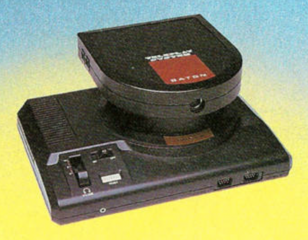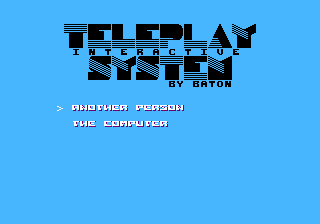Difference between revisions of "Teleplay System"
From Sega Retro
m |
(==History== WIP) |
||
| Line 18: | Line 18: | ||
==History== | ==History== | ||
| + | ===Development=== | ||
| + | In 1990, American engineer Keith Rupp first conceived of the Teleplay System as a means for gamers to play head-to-head against others from across the country over the internet. Recognizing the potential for equipping the then-dominant [[Nintendo Entertainment System]] with online multiplayer capability, he began the process of shopping the idea around to possible investors. One early investor introduced Rupp to [[Nolan Bushnell]], co-founder of [[Atari, Inc. (1972–1984)|Atari]], who grew a strong interest in the hardware. With input from Bushhell, Rupp completed the first prototype. Initially known as the '''Ayota View''', it first made an appearance at the 199x [[Consumer Electronics Show]] in Las Vegas, Nevada, where it was generally well-received.{{ref|http://www.lostlevels.org/200310/200310-baton.shtml}} | ||
| + | |||
| + | As development progressed, Bushnell made the decision to limit the modem's speed to 300 bits-per-second as a cost-saving measure. However, this meant that the Teleplay could no longer viably offer real-time multiplayer, rendering the hardware only suited to "slower" titles like puzzle or strategy games. Additionally, Bushnell (already known in the industry for his questionable promises) only offered him a relatively-meager 5% of potential company profits, and strangely barred him for directly meeting with further investors. To complicate matters, Bushnell later pulled out of the project entirely, leaving its future uncertain.{{ref|http://www.lostlevels.org/200310/200310-baton.shtml}} | ||
| + | |||
| + | In 1992, Rupp independently developed a new iteration of the hardware, largely by himself. Now known under its final name of the Teleplay System, this "final" revision boasted a respectable 2400 bits-per-second real-time connection, and even contained a connection for AT keyboard (the common standard of the era).{{ref|http://www.lostlevels.org/200310/200310-baton.shtml}} | ||
| + | |||
| + | ===Prerelease=== | ||
The sci-fi action game ''[[Terran Wars]]'' was the only compatible game ever announced for the system, despite Baton planning to release an extra eight titles across 1993. One of these, ''[[Combat Aces]]'', has since had a prototype discovered and dumped, allowing for a first-hand look at the {{PAGENAME}}'s unique modem software. | The sci-fi action game ''[[Terran Wars]]'' was the only compatible game ever announced for the system, despite Baton planning to release an extra eight titles across 1993. One of these, ''[[Combat Aces]]'', has since had a prototype discovered and dumped, allowing for a first-hand look at the {{PAGENAME}}'s unique modem software. | ||
Revision as of 02:24, 30 October 2022
| Teleplay System |
|---|
| Made for: Sega Mega Drive |
| Manufacturer: Baton Technologies |
| Type: Network tool |
This teeny-tiny article needs some work. You can help us by expanding it.
The Teleplay System is an unreleased Sega Mega Drive modem developed by Baton Technologies. Intended for a Spring 1993 launch[1], concern over the system's commercial viability and Sega of America's attraction to its primary competitor (AT&T's Edge 16) resulted in the virtually-completed accessory being scrapped entirely.[2]
Contents
Hardware
The peripheral was designed to allow Mega Drive (or NES) customers to play each other over the internet using a specialised 2,400bps modem. The project was ambitious, claiming to allow cross-platform play and well support IBM PC AT-spec keyboards, without the approval of either Sega or Nintendo.
List of games with planned support
- Combat Aces (unreleased)
- Terran Wars (unreleased)
History
Development
In 1990, American engineer Keith Rupp first conceived of the Teleplay System as a means for gamers to play head-to-head against others from across the country over the internet. Recognizing the potential for equipping the then-dominant Nintendo Entertainment System with online multiplayer capability, he began the process of shopping the idea around to possible investors. One early investor introduced Rupp to Nolan Bushnell, co-founder of Atari, who grew a strong interest in the hardware. With input from Bushhell, Rupp completed the first prototype. Initially known as the Ayota View, it first made an appearance at the 199x Consumer Electronics Show in Las Vegas, Nevada, where it was generally well-received.[2]
As development progressed, Bushnell made the decision to limit the modem's speed to 300 bits-per-second as a cost-saving measure. However, this meant that the Teleplay could no longer viably offer real-time multiplayer, rendering the hardware only suited to "slower" titles like puzzle or strategy games. Additionally, Bushnell (already known in the industry for his questionable promises) only offered him a relatively-meager 5% of potential company profits, and strangely barred him for directly meeting with further investors. To complicate matters, Bushnell later pulled out of the project entirely, leaving its future uncertain.[2]
In 1992, Rupp independently developed a new iteration of the hardware, largely by himself. Now known under its final name of the Teleplay System, this "final" revision boasted a respectable 2400 bits-per-second real-time connection, and even contained a connection for AT keyboard (the common standard of the era).[2]
Prerelease
The sci-fi action game Terran Wars was the only compatible game ever announced for the system, despite Baton planning to release an extra eight titles across 1993. One of these, Combat Aces, has since had a prototype discovered and dumped, allowing for a first-hand look at the Teleplay System's unique modem software.
Magazine articles
- Main article: Teleplay System/Magazine articles.
Promotional material
also published in:
- Electronic Gaming Monthly (US) #43: "February 1993" (199x-xx-xx)[3]
- VideoGames & Computer Entertainment (US) #50: "March 1993" (1993-0x-xx)[4]
External links
- Spotlight: Baton Teleplay Modem article by Frank Cifaldi at Lost Levels
References



